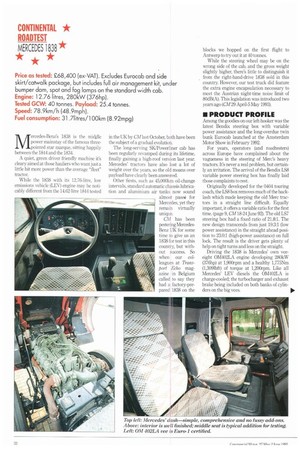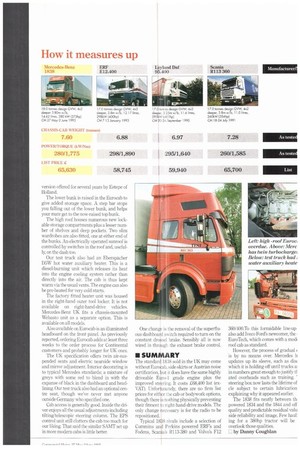Price as tested: £68,400 (ex-VAT). Excludes Eurocab and side skirt/catwalk
Page 34

Page 36

Page 37

If you've noticed an error in this article please click here to report it so we can fix it.
package, but includes full air management kit, under bumper dam, spot and fog lamps on the standard width cab. Engine: 12.76 litres, 280kW (376hp), Tested GCW: AO tonnes. Payload: 25.4 tonnes.
Speed: 78.9km/h (48.9mph).
Fuel consumption: 31 .71itres/100km (8.92mpg) Mercedes-Benz's 1838 is the midglle power mainstay of the famous threepointed star marque, sitting happily between the 1844 and the 1834.
A quiet, green driver friendly machine it's clearyaimed at those hauliers who want just a little bit more power than the average "fleet" tractor.
While the 1838 with its 12.76-litre, low emissions vehicle (LEV) engine may be noticably different from the 14.62-litre 1844 tested
in the UK by CM last October, both have been the subject of a gradual evolution.
The long-serving SKJPowerliner cab has been regularly revamped during its lifetime, finally gaining a high-roof version last year. Mercedes' tractors have also lost a lot of weight over the years, so the old moans over payload have clearly been answered.
Other firsts, such as 45,000km oil-change intervals, standard automatic chassis lubrication and aluminium air tanks now sound almost passé for Mercedes, yet they remain virtually unique.
CM has been pestering MercedesBenz UK for some time to give us an 1838 for test in this country, but without success. So when our colleagues at Transport Echo magazine in Belgium called to say they had a factory-prepared 1838 on the
blocks we hopped on the first flight to Antwerp to try out it at 40 tonnes,
While the steering wheel may be on the wrong side of the cab, and the gross weight slightly higher, there's little to distinguish it from the right-hand-drive 1838 sold in this country. However, our test truck did feature the extra engine encapsulation necessary to meet the Austrian night-time noise limit of 804:IB(A). This legislation was introduced two years ago (CM 29 April-5 May 1993).
• PRODUCT PROFILE
Among the goodies on our left-hooker was the latest Bendix steering box with variable power assistance and the long-overdue twin bunk Eurocab launched at the Amsterdam Motor Show in February 1992.
For years, operators (and roadtesters) across Europe have complained about the vagueness in the steering of Merc's heavy tractors. It's never a real problem, but certainly an irritation. The arrival of the Bendix 1S8 variable power steering box has finally laid those complaints to mgt.
Originally developed for the 0404 touring coach, the IS8 box removes much of the backlash which made keeping the old Mere tractors in a straight line difficult. Equally important, it offers a variable ratio for the first time. (page 9, CM18-24 June 92). The old L87 steering box had a fixed ratio of 21.8:1. The new design transcends from just 19.3:1 (low power assistance) in the straight ahead position to 23.0:1 (high-power assistance) on full lock. The result is the driver gets plenty of help on tight turns and less on the straight.
Driving the 1838 is Mercedes' own veeeight 0M402LA engine developing 280kW (376hp) at 1,900rpm and a healthy 1,775Nm (1,309Ibft) of torque at 1,200rpm. Like all Mercedes' LEV diesels the 0M402LA is charge-cooled: the turbocharger and exhaust brake being included on both banks of cylinders on the big vees. The first LEV units appeared in 1991, in the shape of the vee-six 0M441LA used in the 1834 (previously the 1733), but they didn't make it into the UK before April last year.
The exhaust brake on our test truck was aided by the optional constant drossel (constant throttle) engine brake. This unique design employs a small valve in each cylinder head to choke the flow of the compressed air charge in and out of the cylinder, thus turning the engine into a retarder.
The most prominent of all the new features is the high-roof Eurocab, Available on the Continent on both the Land the wider G cabs, Eurocab adds 75kgs or the weight of a second driver. It offers better standing room, extra storage and it brings with it certain changes to the rest of the cab.
Mercedes-Benz UK says it can provide the glass-fibre, high-roof Eurocab as an option. The price is on application—in other words, much depends on who you are and how many you want to buy. Mercedes' own side-skirt and chequer-plate catwalk kit, also seen on this truck, are not available in the UK yet.
The remainder of the truck's spec resembles that offered in the UK. This includes Merc's own hub-reduction drive axle on air suspension with Arabco electronic control. The front end is steel suspended, Anti-roll bars are retained front and rear.
Put it all together and the Continental spec 1838 seen here is a mainstream contender in the world of efficient, cost-concious freight transport.
• PRODUCTIVITY
The most economical truck ever tested over this Transport Echo's 615km (382mile) test route was Volvo's F12-400 equipped with Geartronic, the new semi-automatic transmission. It achieved 31.331it/100km (9.02mpg). The Mercedes trailed behind but still finished with an impressive figure of 31.681it/100km (8.92mpg). For the record this compares with 37.91it1100km (7,45mpg) achieved by the 1844 tested round CM's Scottish route at 38 tonnes and at motorway speed limits.
It's also worth noting that the Doll trailer used in our test measured just 3.8m--around 200mm (Sins) lower than CM's own test trailer, It is also true that high roof cabs are significantly less aerodynamic than standard ones with comprehensive deflector kits.
With a high overall average speed, the 1838 'managed the highest earnings factors. Stage by stage around the route nationale and hills circuit the big Mercedes delivered excellent economy despite some strong winds.
The timed hill climbs reveal a lazy performance, the lugging tones of the engine adding to the sensation. Overall the times confirm this truck is bet-ter suited to the flatlands and gentler tnotorway climbs than its torque figure might suggest.
The 1838's productivity is further enhanced by some useful payload figures. Mercedes is no longer the heavyweight it once was. This machine's 7.6-tonne weight proves it. Unlike most manufacturer-prepared test trucks, this one also curried a spare wheel and carrier in addition to the extra bodywork. And like the 184-4 it also had a full toolkit on board.
• ON THE ROAD
When we tested the new Bendix steering box in the 1844 we weren't slow to praise it. Our re-acquaintance with it on the 1838 reminded us how much better it is than the old box. The driver experiences a tighter rein over the bends. Turns need less correction and, while unnoticeable to the driver, the gradually increasing power assistance makes slow, tight manoeuvres a breeze.
The number of turns lock-to-lock has risen from a little over four to five. Still there's less correction needed in the steering at speed, even with a full 24 tonnes on the trailer bogie. Having also tried it in the 0404 coach since the 1844, we can say the steering quality is equally good in truck and bus chassis. Mercedes' steeVair suspension continues to offer a rather spongy ride, more a product of the front axle's movement than the rear. That said, driver and passenger still enjoy a comfortable ride thanks to the talents of Mr Isringhausen. Handling is predictably basic and safe, and competent for all that. Like the 1831 and 1844 tested recently; the 1838 enjoys well-damped suspension which, along with the stiffened cab mounts used with Eurocab, limit roll well.
Hefty anti-roll bars are fitted front and rear on the big Mercs, These restrict excessive chassis roll and help keep the ship upright. Overall handling has improved, but much of this is down to the steering improvements.
• CAB COMFORT
The high-top Eurocab was finally introduced in response to the flood of double-hunk, highroof cabs being introduced across the industry. Most recent among these is that from fellow countryman MAN with its factory fitted Roadhaus option on the F90 heavy range. Eurocab also follows an add-on glass-fibre version offered for several years by Estepe of Holland.
The lower bunk is raised in the Eurocab to give added storage space. A step bar stops you falling out of the lower bunk, and helps your mate get to the now-raised top bunk.
The high roof houses numerous new lockable storage compartments plus a lesser number of shelves and deep pockets. Two slim wardrobes are also fitted, one at either end of the bunks. An electrically operated sunroof is controlled by switches in the roof and, usefully, on the dash too.
Our test truck also had an F,berspacher 1)5W hot water auxiliary heater. This is a diesel-burning unit which releases its heat into the engine cooling system rather than directly into the air. The cab is thus kept warm via the usual vents. The engine can also be pre-heated for very cold starts.
The factory fitted heater unit was housed in the right-hand outer tool 'locker. It is not available on right-hand-drive vehicles. Mercedes-Benz UK fits a chassis-mounted Webasto unit as a separate option. This is available on all models.
Also available on Eurocab is an illuminated headboard on the front panel. As previously reported, ordering Eurocab adds at least three weeks to the order process for Continental customers and probably longer for UK ones.
The UK specification offers twin air-suspended seats and electric nearside window and mirror adjustment. Interior decorating is to typical Mercedes standards; a mixture of greys with some red to blend in with the expanse of black in the dashboard and headlining Our test truck also had an optional centre seat, though we've never met anyone outside Germany who specified one.
Cab access is generally good. Inside the driver enjoys all the usual adjustments including tilting/telescopic steering column. The EPS control unit still clutters the cab too much for our liking. That said the similar SAMT set up in more modern cabs is little better. One change is the removal of the superfluous dashboard switch required to turn on the constant drossel brake. Sensibly all is now wired in through the exhaust brake control.
• SUMMARY
The standard 1838 sold in the UK may come without Eurocab, side-skirts or Austrian noise certification, but it does have the same highly driveable Eurol grade engine plus the improved steering. It costs £68.400 list (ex-VAT). Unfortunately, there are no firm list prices for either the cab or bodywork options, though there is nothing physically preventing their fitment to right-hand-drive models. The only change necessary is for the radio to be repositioned.
Typical 1838 rivals include a selection of Cummins and Perkins powered ERF's and Fodens, Scania's R113-380 and Volvo's F12
360/400,To this formidable line-up also add Iveco Ford's newcomer, the , EuroTech, which comes with a mod, roof cab as standard.
However, the process of gradual is by no means over. Mercedes h updates up its sleeve, such as disi which it is holding off until trucks al in numbers great enough to justify tl ated overheads such as training. ' steering box now lasts the lifetime of cle subject to certain lubrication explaining why it appeared earlier.
The 1838 fits neatly between th, powered 1834 and the 1844 and off quality and predictable residual valu side reliability and image. Few haul: ing for a 380hp tractor will be overlook those qualities.
by Danny Coughlan




















































































